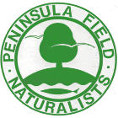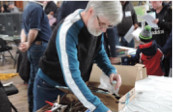A Message From the President
I
t is hard to believe that the Peninsula Field Naturalists have held monthly
meetings through Zoom for two years. Video conferencing has been a valuable
tool for our club over this time. Our guest speakers did not have to travel
during inclement weather, and we broadened the search area to obtain a
presenter.

Bob photographing a Milksnake
© Jean Hampson
Though Zoom conferencing has been advantageous, gathering for an in-person
event is preferred. The return to indoor gatherings is being welcomed and
well-received. Jean and I represented the PFN at the NPCA Conservation
Awards in September , and it was great seeing Marcie Jacklin and Kerry
Kennedy each receive an Individual Award of Merit. Catching up with
friends at the Ontario Field Ornithologists annual convention and sharing
group activity reports at the Ontario Nature Carolinian East Regional
Meeting certainly is better in a hall or room than looking at a computer
monitor. Presenting The Wild West of Cuba to the Bert Miller Nature Club
in September made Jean and I feel we need in-person meetings again.
With that said, I thought I would take some time here to let you know that
the Executive are working hard to ensure we have a room available for 2023.
Unfortunately , we have not been able to confirm our previous meeting
place, so if anyone has suggestions, please e-mail us at
info@peninsulafieldnats.com.
I look forward to seeing you all again for a PFN indoor meeting. Until then,
go out and spend time enjoying nature.
Bob Highcock, President
In Memory of Roman Olszewski 1950 - 2022
O
n September 12, 2022, PFN member Roman Olszewski passed away. Roman was
the Director of Technical Services for Athletics Ontario. He dedicated
nearly 40 years to the sport of Track and Field, and in 2021, Roman was
inducted into the Athletics Ontario Hall of Fame.
Roman was a long-time member of the Peninsula Field Naturalists and The
Niagara Peninsula Geological Society.
Roman was an active member of the PFN, having served on the Board from 1997
to the present as a Vice-President, President, Past- President and most
recently, Director. Roman had extensive stamp, coin, mineral and lichen
collections. His lichen collection is one of the largest private
collections in Ontario and will be donated to Guelph University. His vast
knowledge of lichens had him leading outings for the Peninsula Field
Naturalists, which many members and guests thoroughly enjoyed.
The Executive and club members will greatly Roman miss Roman. PFN has made a
memorial donation to Parkinson Canada to honour Roman's contribution to our
club.
Hidden Corners: East Andes Ecuador
by Janet Damude
O
wen Bjorgan likes to spend time in biodiversityhotspots. He likes being
in Niagara because it is the biodiversity hotspot of Ontario. So the next
logical step forward for Owen was to spend time in the most incredible
biodiversity hotspot in the world. With that in mind, Owen travelled to
Ecuador to see the Amazon rainforest.
Owen spoke to the Peninsula Field Naturalists on Zoom about his trip to
Ecuador at our March 28 meeting. He travelled there while filming his
documentary "Hidden Corners: East Andes Ecuador." You can watch the video
on his YouTube channel, Owen's Hiking and Adventures, at
https://youtu.be/8UhCmLj_c5E,
along with the other Hidden Corner documentaries Owen has produced.
The area that Owen visited was on the east side of the Andes mountains,
which connect with the Amazon rainforest. The Amazon Rainforest spans
several South American countries, including Brazil, Peru, Colombia,
Ecuador, Bolivia, Guyana and Venezuela. The Andes mountains help make the
Ecuadorian section wetter than other rainforest areas. According to Owen,
this area of Ecuador has two seasons: wet and wetter. All this rain means
that some sections are regularly flooded during the rainy season. Owen
described trees with rivulets ofwater pouring down them. All of this
moisture and the longer days create a biodiversity bonanza.
He told us about trees draped in mosses, lichens, and even other plants
(epiphytes). Then, Owen showed us pictures of the exciting animals he
encountered, such as toxic stick insects, Long-horned Beetles as big as
your hand, Cane Toads the size of cow plops, and Earthworms that look
like short garden hoses. At one point, he thought he had encountered the
highly venomous snake called the Fer-de-lance, but luckily it was a
clever mimic.
Owen also described his many positive experiences with the local Ecuadorian
people. He told of how great they were with guiding and surviving in the
wild. They shared important experiences with him, such as a days-long
father-and-son fishing trip. They also helped him to survive a bout of
Dengue Fever and inspired him to keep exploring after he recovered. We're
all glad he survived his trip and encounters with snakes and giant crickets
so we can hear about more exciting adventures in the future.
Thank you, Owen, for another exciting and enjoyable presentation.
Carolinian Canada
by Mary-Lou Davidson
D
r. Stefan Weber of Carolinian Canada was the speaker for our April
meeting, and his knowledge of native plants was awe-inspiring.
Dr. Weber studied interactions among co-flowering spring ephemerals at the
University of Guelph. He received a Ph.D. in Biology from McMaster
University, researching invasive plants, seed conservation and ecosystem
restoration. Stefan is the founder of Ontario Plant Restoration Alliance,
a member of the Ontario Biodiversity Council and currently works with
Carolinian Canada. Dr. Weber resides in Niagara and has recently appeared
in the best-selling sci-fi novel "Bloom" by Kenneth Oppel.
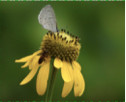
Summer Azure on Cutleaf Coneflower.
© Jean Hampson
Stefan informed us he lives in St. Catharines and started his first garden
three years ago. He stressed the importance of native plant gardening to
support the ecosystem, diversity and food chains. Native plants support
insects which in return support birds. Birds indicate the health of the
ecosystem. He suggested we invite nature into our backyards.
We live in the most biodiverse region of Canada but also the most populated
and most fragmented because of the colonizing of Ontario. Therefore, we
must support indigenous-led restorations as we are losing native plant
diversity.

Baltimore Checkerspot adult.
© Jean Hampson
Mutualisms are reciprocal relationships between all organisms. Native plants
have close relationships with insects that pollinate the plant. Stefan
showed a slide of native Turtleheads in his garden and explained that to be
pollinated, the Turtleheads require native bumblebees. The Baltimore
Checkerspot butterfly depends on the Turtleheads to lay its eggs. The Giant
Swallowtail, Ontario's largest butterfly, can lay eggs on two native
plants: the Prickly Ash and the Hop Tree. It was interesting to learn that
its caterpillar disguises itself as a bird dropping and, if that does not
work, then as a snake to scare predators away.

Baltimore Checkerspot larvae on Bee Balm
© Bob Highcock
Stefan studied habitat restoration at McMaster University and worked with
the Ministry of Transportation to create prairie and grassland recreation
along highways. Various soils and native plants were examined for mass
blooming to benefit insects, including native parasitic bees. This is a
good sign as it means there is a healthy native bee population.
Carolinian Canada and partners spearheaded a seed conservation strategy.
Unfortunately, very few native plants are protected, and old groves like
the native plum can be cut down. As a result, we have witnessed the
disappearance of old woodlots.
The Carolinian Zone, stretching from Toronto to Windsor, is Canada's most
diverse and fragile ecoregion. This zone is home to 1,500 different plant
species. Thirty-seven of these are legumes (in the bean family) which are
important for fertilizing soils and providing nutritious food for
wildlife.
Dr. Weber treated us to several photos of native plants that he encouraged
us to include in our gardens. He is full of fascinating information and
his time to speak went by too quickly. Nevertheless, we thoroughly enjoyed
his presentation to the Peninsula Field Naturalists and look forward to
hearing from him again.
For more information on plant conservation and native plant gardening,
please go to www.caroliniancanada.ca
, where you'll find a wealth of information, including native plant garden
kits.
Identifying Warblers
By Jean Hampson & Bob Highcock
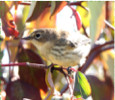
Yellow-rumped Warbler
© Jean Hampson

Prairie Warbler.
© Jean Hampson
D
ur first Zoom meeting for the Fall 2022 session took place on September 26,
and it was an interactive presentation about warblers
by Marcie Jacklin.
Marcie showed photos of warblers in the province of Ontario and asked those
present to point out defining features to pinpoint identification. t was a
fun workout for our brains. Identifying warblers without a completely
unobstructed view is difficult, but Marcie demonstrated that getting a
photo showing even just part of the bird can be helpful.

Black-throated Blue Warbler.
© Jean Hampson
Guides such as The Warbler Guide (Tom Stephenson and Scott Whittle) are a
helpful resource. In addition, since the views that we often have of the
birds are high above in the trees, a guide showing icons of tail patterns
and under- tail coverts is useful.
Warbler identification can be challenging, but Marcie demonstrated that with
practice and attention to detail, we could all work on improving our
birding skills
PFN Quiz
by Marlene Sanders
- What is the largest ocean on Earth?
- What was the date of the Summer Solstice or Litha in the Northern Hemisphere this year?
- How many national parks are in Northwest Territories and which province has the most national parks?
- What is the oldest living plant species?
- Do you know there are wild bison in Canada? Where can the largest herd be found?
The answers can be found on the back page of this newsletter.
Earth Day Walk for Friends of Malcolmson
By Jean Hampson & Bob Highcock
I
n late March of this year, Claire Theijsmeijer of the Friends of Malcolmson
Eco-Park contacted the PFN to let us know that they would be able to have
an Earth Day event at the municipal park again. Claire also asked if we
would be interested in leading a birding hike. The PFN was pleased to hear
that the Earth Day event had returned to Malcolmson Eco-Park and
enthusiastically accepted the request.
The hike was popular in the past, and it drew interest again on Saturday,
April 23. In addition to PFN members attending the walk, members of the
public took the opportunity to bird watch along the trails in the park.

The group of participants.
© Jean Hampson

Hairy Woodpecker.
© Jean Hampson
Birds observed during the event included Canada Goose, Mallard, Mourning
Dove, Killdeer, Ring-billed Gull, Double-crested Cormorant, Red- bellied
Woodpecker, Downy Woodpecker, Hairy Woodpecker,Northern Flicker, Blue Jay,
American Crow, Common Raven, Black-capped Chickadee, Ruby-crowned Kinglet,
Golden-crowned Kinglet, Carolina Wren, European Starling, Eastern Bluebird,
Hermit Thrush, American Robin, House Sparrow, House Finch, American
Goldfinch, Chipping Sparrow, Dark-eyed Junco, White-throated Sparrow, Song
Sparrow, Red-winged Blackbird, Brown-headed Cowbird, Common Grackle,
Yellow-rumped Warbler and Northern Cardinal.
Members of the public enjoyed the walk and learning about the birds we saw
in the park. It was a fun morning for all. The PFN will gladly lead a
hike for future Earth Day events organized by the Friends of Malcolmson
Eco-Park.
Wildflower Walk at Louth C.A.
By Jean Hampson & Bob Highcock

Large White Trillium
© Jean Hampson
T
he morning of Sunday, May 1, was cool, but that did not stop members of the
PFN in their search for wildflowers and ferns at Louth Conservation Area in
Lincoln.

Canadian Wild Ginger
© Jean Hampson
Wildflowers observed along the trails included Blood Root, Yellow Trout Lily,
Large-flowered Bellwort, Red Trillium, Canadian Wild Ginger, Blue Cohosh,
Dutchmanís Breeches, Cut-leaved Toothwort, Large White Trillium and
Sharp-lobed Hepatica.

Walking Fern
© Jean Hampson
We paused to admire Louth Falls, which was flowing well. The group then
returned to the top of the Niagara Escarpment and walked on the Bruce Trail
to Staff Avenue. Here we navigated the rocky path. The large crevices
contained many species of fern, including Walking Ferns. Oak Sedge was
growing beside the pathway.

Louth Falls
© Jean Hampson
Bird species observed during the walk include Red-bellied Woodpecker,
Northern Flicker, Blue Jay, Black-capped Chickadee, Winter Wren, Carolina
Wren, Eastern Bluebird, Hermit Thrush, American Robin, White-throated
Sparrow and Northern Cardinal.
In the 90 minutes the group spent at the conservation area, we observed a
good variety of plant and animal species.
Cherie Road Park Outing
by Doug Gillard
W
hen we sat down to plan the club's outings for the upcoming few months,
we discussed how to increase the number of excursions we could fit into the
migration season. So, we decided to do a few mid-week evening outings
The first was on Tuesday, May 10, at Cherie Road Park in north St.
Catharines. Ten of us were out on a cool evening looking for spring
migrants, especially warblers. I was the leader for this walk, but I needed
a lot of help from the more experienced birders in our group to identify
the birds. On this outing, Bob, Jean, Shirley and Rafael were excellent
birders at identifying the birds by sight and sound. We all saw many birds
that night, and if we didn't know what they were, we would ask the
birding experts and then add them to our list. I got six new birds for my
year's list that evening.
Cherie Road Park is a relatively unknown park located off Cherie Road in
north St. Catharines. The creek that runs through the park is called
Walker's Creek—so named for the Walker family who worked a 300-acre
farm in the block between Niagara Street and Vine Street to the east and
west and Parnell Road and Linwell Road to the north and south. George
Walker bought the fruit and vegetable farm in the early 1880s and named it
Sunnyside Farm. The family started selling the land to developers in the
early 1950s, and one of the streets in the new development was called
Sunnyside Drive.
The trail that runs through Cherie Road Park is part of the Waterfront Trail
system. The Waterfront Trail stretches over 3600 kilometres along the
shores of most of the Great Lakes in Ontario.
After searching for birds for over two hours, we had a list of 48 species we
had seen. Some of the highlights for this outing were Eastern Phoebe,
Blue-headed Vireo, Swainson's Thrush, Baltimore Oriole, Rose-breasted
Grosbeak and several warblers, including a Black-and- white, a Nashville,
Common Yellowthroat, Northern Parula, Magnolia, Blackburnian, Yellow,
Chestnut-sided, Palm, Yellow-rumped and a Black-throated Green Warbler.
The weather was great; the birds were there for us to see. It was a fun
evening with our birding friends in a small, relatively unknown St.
Catharines park. It's always nice to get out into nature, and a bonus to
introduce this park to a few fellow birders.
Spring Bird Walk
by Barb West

The Group
© Jean Hampson
S
aturday, May 14, was a gorgeous spring day as we searched for spring
migrants in Mary Malcolmson Park.

Red-headed Woodpecker
© Jean Hampson
We saw thirty-nine species of birds. Some common ones were Goldfinch,
Red-winged Blackbird, American Robin, Gray Catbird, Black-capped
Chickadee, Northern Cardinal, Downy Woodpecker, Common Grackle, Blue Jay,
Starling and Mourning Dove. In addition, we saw many warblers, including
Yellow, Magnolia, Blackburnian, Bay-breasted, Tennesee, Black-throated
Blue, American Redstart, Northern Parula, Cape May, Yellow-rumped and
Black-throated Green. The highlight of our day was seeing a Red-headed
Woodpecker. They haven't been spotted in the park for several years.

Ruby-throated Hummingbird
© Jean Hampson
We also saw the beautiful Scarlet Tanager a couple of times and several
Baltimore Orioles. In addition, a Great Horned Owl flew out of a tree,
and we heard a Wood Thrush. Other birds we spotted were Northern Flickers,
Carolina Wren, a Ruby-throated Hummingbird, Least Flycatcher, Blue-headed
Vireo, Warbling Vireo, Red-eyed Vireo, House Wren, Song Sparrow and House
Finch. There was also a Mallard duck on the pond. Overall, it was a
successful outing.
Martindale Area Birding
by Jean Hampson

Blue-winged Teal duck
© Jean Hampson
O
n May 21, PFN club members met at the Green Ribbon Trail for birding in the
Martindale area of St. Catharines.

American Bullfrog
© Jean Hampson
We were hoping to find some warblers but unfortunately encountered very few.
We did see thirty species of birds at the Green Ribbon Trail. A beautiful
male Blue-winged Teal glided across the pond, and a Wood Duck perched on a
fallen tree. We observed a pair of Great-crested Flycatchers that appeared
to be inspecting nest holes in a dead tree. Eastern Kingbirds and Gray
Catbirds were in the trees along the path, as well as a pair of Baltimore
Orioles gathering nesting material. Our only warbler encounter was a
Tennessee Warbler we heard but did not see.

Canada Goose gosling
© Jean Hampson
Next, we explored Francis Creek Nature Area. We found twenty species here,
including a flyover by a Cooperís Hawk. Then on to the Merritt Trail off
Martindale Road.
Here we found eighteen species, including the only warblers we could see: a
Yellow Warbler and a Common Yellowthroat. An unusual Common Goldeneye
captured our attention for a while, the baby Canada Geese were napping in
the sun, and the large bullfrogs posed, so everyone had a chance to take a
nice photo.
St. John's C.A. Evening Walk
By Jean Hampson

Time for a rest stop
© Jean Hampson
S
t. John's Conservation Area is a beautiful spot in Fonthill, and we
weren't disappointed with our Evening Walk on May 24. Many readers
may be familiar with the accessible trout pond near the parking area, but
many trails extend throughout the park that immerse hikers in Carolinian
species of trees, plants, birds and animals. Our hike on the moderately
difficult St. John's Ridge Trail tested the endurance of our hardy
group, but the views and birds we enjoyed made it worthwhile. We saw many
species of ferns, pungent Skunk Cabbage and flowering plants. We even found
some comfy benches suitable for a quick rest stop.

One of the ferns along the trail
© Jean Hampson
On this hike, we heard or observed twenty-two species of birds. Highlight
birds included Hooded Warblers and Scarlet Tanagers. St. John's C.A.
is one of the most reliable spots in Niagara to find these species.
We wandered back towards the pond to watch a Canada Goose family residing
there and reflected upon the beautiful evening until the biting insects
encouraged us to head home.
Rim of Africa Trail Walk
By Bob Highcock

Horses on the trail
© Jean Hampson
I
t was an overcast morning when members of the PFN met in Parking Lot A in
Short Hills Provincial Park. At the same time, family and friends of
Bluebird champions Aurelio, Felix and Margaret were gathering for a
memorial bench dedication for the trio. Before the start of the hike, we
had a pleasant chat with Aurelio's son Tony, a classmate of Jean and
mine from Brock University. We reminisced about a friend who is no longer
with us, wished each other well with our day's activities and headed in
opposite directions along the Rim of Africa -Bruce Trail Friendship
Trail.
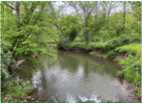
Twelve Mile Creek
© Bob Highcock
The section of the Bruce Trail at Short Hills Provincial Park our group
walked along is twinned with a section of the Rim of Africa Trail, located
in South Africa. The twinning marks friendship and international
cooperation between the two organizations.
This trail walk is one of my favourites in Niagara. We hiked south on the
trail along the banks of the meandering Twelve Mile Creek to a meadow not
too far from the Wiley Road entrance to the provincial park. In the spring,
you are sure to find migrating birds and, in the summer, breeding birds,
butterflies and dragonflies. And on occasion, you may run into some people
enjoying the trail on horseback.
Bird species observed during the walk include Yellow- billed Cuckoo,
Ruby-throated Hummingbird, Great Blue Heron, Turkey Vulture, Red-tailed
Hawk, Red-bellied Woodpecker, Downy Woodpecker, Eastern Wood-Pewee,
Traill's Flycatcher, Eastern Phoebe, Great Crested Flycatcher, Red-eyed
Vireo, Blue Jay, American Crow, Black-capped Chickadee, Blue-gray
Gnatcatcher, House Wren, Carolina Wren, Gray Catbird, American Robin,
American Goldfinch, Field Sparrow, Song Sparrow, Eastern Towhee, Baltimore
Oriole, Red-winged Blackbird, Brown-headed Cowbird, Common Grackle,
Blue-winged Warbler, Common Yellowthroat, Yellow Warbler, Blackpoll
Warbler, Northern Cardinal, Rose-breasted Grosbeak, and Indigo Bunting.
Don't Step on the Snails!
by Doug Gillard
O
n Tuesday, June 7, eight of us enjoyed a beautiful evening walk around the
Outlet Collection Ponds in Niagara-on-the-Lake. For hours before this
evening's outing, it rained non-stop. At about three o'clock, the sun came
out for a few minutes and then it started to rain again. Finally, as the
weatherman forecasted, it cleared up at five o'clock. I was pacing the
floors all day, constantly looking out the window and checking the weather.
After the weather cleared, the air was enjoyable, cool and fresh. With all
the rain during the day, I thought the path would be muddy, and a few other
people did too and wore their rubber boots, but it wasn't. All the rain
brought many snails onto the path, and Barb kept saying, "don't step on the
snails." Walking, looking for birds, and trying to avoid the snails was
hard. So, as we were walking, there was the occasional "oh no" after you
heard the crunching sound of a stepped-on snail. "Sorry, Barb."
The Outlet Collection Ponds are well known to many people as a place to see
birds and a nice place to go for a walk. Carol and I have visited the ponds
many times at different times of the year. In this area of
Niagara-on-the-Lake, the Garden City Raceway operated from 1964 to 1976.
When the mall was built in 2014, the Ministry of the Environment required a
stormwater management system to be made to handle rainwater and melted
snow. It was designed with five ponds separated by stone berms, and each
pond performs a specific water management function. They planted a variety
of grasses, brush and small trees and left them to evolve naturally. At
different times of the year, butterflies, moths, snails and birds can be
seen. Niagara-on-the-Lake town employees cut the weeds and grass along the
path a few times during the year. The weeds and grass along the pathway
needed to be cut, so we picked up a few ticks. You must be aware and
vigilant in checking yourself for ticks.
We only saw nineteen species of birds on this outing, with the highlight
being a mother Mallard with her seven babies. We also saw a Great Egret, a
Willow Flycatcher and six Yellow Warblers. In addition, we stopped to
watch three rabbits chasing each other in the field as we were leaving the
ponds. Even though the Outlet Collection Ponds is a popular place to visit,
it was Mary- Lou's first time here. One reason we do the club outings is
to introduce different areas to interested nature lovers.
Mountain Locks Park Insect Crawl
By Jean Hampson
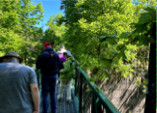
Crossing the pedestrian bridge
© Bob Highccock
O
n June 18, we once again visited Mountain Locks Park to search for
butterflies and other insects. Our group walked along the Merritt Trail
until we crossed the pedestrian bridge over the old canal to the Bruce
Trail and an open wildflower field. Immediately we started seeing
butterflies such as Peck's and European Skippers, and Little Wood
Satyrs. Dragonflies like the Twelve-spotted Skimmer buzzed overhead.
Regarding birds, we observed Mallards in the canal and Downy Woodpeckers,
Baltimore Orioles and Northern Cardinals all feeding young. The star of the
show was a beautiful Silver-spotted Skipper that was high up on a vetch and
visible to all. This is a lovely area for observing insect life.
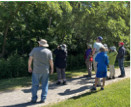
The group looking for birds
© Bob Highcock
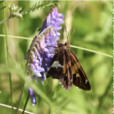
Silver-spotted Skipper
© Jean Hampson
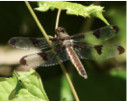
Twelve-spotted Skimmer
© Jean Hampson
June 30 Ice Cream Walk
By Jean Hampson
T
he annual ice cream walk from Jaycee Park to Port Dalhousie is always a
great way to kick off summer. The Barn and Cliff Swallows nesting under
the pedestrian bridge are a highlight as they swoop over Martindale Pond
and under our feet. We could see a family of Mute Swans with young cygnets
and a Great Blue Heron as we crossed into Port Dalhousie. We were impressed
by the quick and friendly service at Old Port Dairy Bar and the delicious
flavours of ice cream available. As we enjoyed our scoops and shakes, we
admired the sailboats in the marina and chatted with each other and
passersby.
I hope my fellow club members enjoy this annual outing as much as
I do.
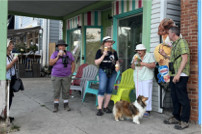
The group enjoying the prize, ice cream
© Bob Highcock
Glenridge Quarry Naturalization Site Outing
by Doug Gillard
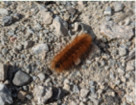
Woolly Bear caterpillar
© Debbie Wright
O
n top of the escarpment, the Peninsula Field Naturalists' first outing for
the fall season on September 10 was to the Glenridge Quarry Naturalization
Site in south St Catharines. The Naturalization Site, which opened to the
public on September 28, 2004, has evolved from an open pit quarry to a
municipal landfill to the Glenridge Quarry Naturalization Site. Located
next to the quarry was the Canadian Drive-in. It was opened on July 17,
1947, and closed in 1982. When it opened, it was one of only five drive-ins
in Canada, and the price of admission was $.50 per adult. I talked about
the area's history, and several people started reminiscing about their
memories of the drive-in.
There are many paths throughout the site, and we followed the longest route
on this outing. Nine of us came out to take in the beauty of this
constantly evolving site. We walked past the Large Clay Borrow Pit Pond and
after checking with everyone, we climbed to the top of the Summit
Overlook.
It was a beautiful early fall day with above-average temperatures.
Unfortunately, there weren't many birds or butterflies to see, but it was
an enjoyable outing. It's always good to be out in nature and exploring its
beauty.
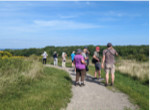
Walking on one of the paths.
© Debbie Wright
Soon after we started our walk, a large committee of thirty-seven Turkey
Vultures was seen taking flight from their roosting place. At one time, the
Turkey Vultures roosted on the roof of a church below the escarpment, but
the church has been recently torn down. I don't know where they are
roosting now, but they may have found a new spot nearby. We also saw
several Grey Catbirds and ten American Goldfinches. It was a pleasure to
see quite a few Monarch Butterflies too. Next, our path led us to Pit Pond,
where we saw seven Canada Geese, two Trumpeter Swans and a few Mallards.
The highlight of our stop at the pond was watching a young couple feeding
the catfish. They visit the pond once a week to feed the fish, and we
were surprised to see so many Black Bullhead Catfish in the pond. There
were hundreds of fish coming to the surface for their breakfast.
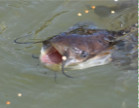
Black Bullhead Catfish.
© Shirley Chambers
As always, it was fun visiting with others that love nature.
Introducing Bev and Ken Byberg
by Doug Gillard
I
want to introduce to our members two new members to the Peninsula Field
Naturalists Club. Bev and Ken Byberg. Through their foundation, they will
give an annual donation of $1000.00 to the PFN. On behalf of the PFN,
thank you for the gift and welcome to the Peninsula Field Naturalists.
Ken was born and raised in Northern Ontario on a dairy farm in the Little
Claybelt, approximately 150 km north of North Bay. After high school, he
enrolled in Haileybury School of Mines, graduating in 1965 and 1967. Then
in 1977, he attended Laurentian University to complete his professional
engineering status. Between 1965 and 1980, he was employed by Inco in
Sudbury in various positions up to Underground General Foreman.
Bev was born in the UK and immigrated to Canada at age ten. She resided in
Peterborough and Hamilton until marrying Ken in 1967. During this time, she
graduated as a Dental Assistant.
In 1981 the couple, with two girls, relocated to Manitouwadge, Ontario, some
400 km north of Sault Ste. Marie. Here Ken worked for Noranda Mines as Chief
Mines Engineer and Mine Superintendent of a large 5000- ton per day
underground base metal mine. Bev raised two girls, looked after the
household, and later owned and operated a ladies' clothing store. In 1993,
with ore reserves declining and operations shutting down, the family moved
to Pelham (Effingham) and started two companies due to a hiatus in mining.
Ken purchased Meta Lake Lodge, a fly-in fishing and hunting lodge north of
Nakina, with a partner, and M'Lady Distributors, a wholesale greeting card
company centred in the Niagara Peninsula. In 1997, after selling Meta Lake,
they purchased Island 10 Fishing Retreat, a remote resort on Lady Evelyn
Lake, a seven-hour drive north of Niagara. The resort is now run by their
daughter Andrea. Not finished with mining, Ken and his brother Terry, in
2002, started and ran Silver Eagle Mines, with holdings in Mexico and
Canada. The recession of 2010 crippled Silver Eagle as it did with most
mining ventures.
Both Ken and Bev love the outdoors and the Canadian wilderness and cherish
what we in Canada take for granted. Ken was a hunter and fisherman, loved
and respected wildlife, and spent many hours fishing and enjoying the north
from their floatplane, which they still own.
In 2017 after sponsoring various charities, they felt it was more beneficial
to start their foundation, emphasizing bursaries, non-profit and volunteer
organizations, performing work, helping environmental, Christian, animal,
and wildlife husbandries etc.
"Of all God's creations, birds are the most impressive. They can fly,
communicate, and travel, are beautiful, colourful, cheerful, friendly, and
bring joy to anyone watching. As a matter of interest, the three closest to
our hearts are the Ruffed Grouse, hummingbird, and owl families."
"It is a pleasure to be associated with a group dedicated to preserving
these creatures." - Bev and Ken Byberg
Ontario Breeding Bird Atlas Update
by John E. Black
A
s of this writing, most data for the Atlas Niagara Region 11 has now been
entered for the first two years. Fifty-two participants worked 1,315 hours,
submitted 12,780 records and observed 129 species in the twenty-five
Squares of Region 11.
2023 is an important year for the Atlas in Region 11. First, some squares
received a small amount of coverage and will be improved by the process of
"Square Bashing." A large number of point counts have to be made as
well for many squares. Finally, two squares have lost the birders assigned
to work them, and new birders are required.
Marcie Jacklin, the Regional Coordinator for Region 11, will present data on
the 2023 atlas year in a webinar in early 2023. You will learn about Square
Bashing, Point Counts, other Surveys and Data Entry. You might contact her
if you are interested in participating in the Atlas in 2023.
(mjacklin@brocku.ca)
You can learn more about the Atlas by visiting
https:// www.birdsontario.org/jsp/download/obba_guide_en.pdf
There is a total of 47 Regions covered by the OBBA. This table shows the
results from the first 15 Regions (This list includes Toronto, Hamilton
and Simcoe and other regions that might be of interest).
| Region |
Checklists |
Participants |
Squares |
Records |
Species |
Hours |
Hours (peak) |
Points (In Person) |
| Ontario (Province) |
88182 |
1334 |
2822 |
810692 |
269 |
62554.1 |
41087.6 |
20380 |
| 1. Essex |
1419 |
79 |
32 |
10674 |
132 |
1170.7 |
693.2 |
282 |
| 2. Chatham-Kent |
1343 |
54 |
35 |
10394 |
143 |
776 |
547.5 |
426 |
| 3. Lambton |
1182 |
66 |
40 |
10062 |
155 |
1062.4 |
741.2 |
318 |
| 4. Middlesex-Elgin |
3276 |
146 |
70 |
22789 |
159 |
2472.6 |
1515 |
944 |
| 5. Norfolk |
2247 |
98 |
35 |
24197 |
165 |
2087.5 |
1084.4 |
679 |
| 6. Huron-Perth |
2324 |
73 |
48 |
19966 |
155 |
921.5 |
598.4 |
607 |
| 7. Waterloo |
2814 |
108 |
30 |
23671 |
165 |
1945.6 |
1157.4 |
461 |
| 8. Bruce |
1814 |
89 |
61 |
16115 |
176 |
1165.1 |
929.1 |
274 |
| 9. Greyd |
2245 |
67 |
36 |
18775 |
149 |
1436.1 |
861.2 |
224 |
| 10. Halton |
2373 |
141 |
38 |
22290 |
171 |
1984.1 |
1250 |
564 |
| 11. Niagara |
2017 |
52 |
25 |
12780 |
129 |
1315.7 |
806.5 |
101 |
| 12. Toronto |
1837 |
143 |
16 |
17912 |
132 |
1935.2 |
1180.1 |
182 |
| 13. Simcoe |
4139 |
168 |
62 |
34741 |
184 |
3504.3 |
2087.3 |
594 |
| 14. Kawartha |
1032 |
98 |
26 |
10969 |
161 |
583.6 |
430.7 |
149 |
| 15. Hamilton |
2381 |
110 |
31 |
21154 |
155 |
1745.9 |
1070.6 |
401 |
Great Canadian Birdathon 2022
By Jean Hampson & Bob Highcock

Fitzgerald Flickers
© Bob Highcock
F
or the 2022 Birdathon, the Fitzgerald Flickers (Jean and Bob) started their
24-hour tally at Fifty Point Conservation Area in Grimsby at 12:45 pm on
Thursday , May 19. While at this eBird hot spot, we recorded Canada Goose,
Mourning Dove, Chimney Swift, Killdeer, Ring-billed Gull, Herring Gull,
Caspian Tern, Common Tern, Double-crested Cormorant, Downy Woodpecker,
Northern Flicker, Eastern Phoebe, Great Crested Flycatcher, Eastern
Kingbird, Warbling Vireo, Blue Jay, Northern Rough-winged Swallow, Purple
Martin, Tree Swallow, Barn Swallow, House Wren, European Starling, American
Robin, House Sparrow, American Goldfinch, Song Sparrow, Swamp Sparrow,
Baltimore Oriole, Red-winged Blackbird, Common Grackle, Tennessee Warbler,
Yellow Warbler, Blackpoll Warbler and Northern Cardinal.
Our next stop was the Grimsby Wetlands. We spent under one hour at this
location and added Mallard, American Coot, House Finch and Savannah
Sparrow. Unfortunately, no shorebirds.

Trumpeter Swan
© Jean Hampson
During our coffee break, we observed Rock Pigeon and then headed to the
Forty Mile Creek Side Trail. A big surprise here was a lone adult Trumpeter
Swan. Other new species here were the Spotted Sandpiper and Red-bellied
Woodpecker.
Next, we looked for grassland birds in Grassie on top of the Niagara
Escarpment. A Great Blue Heron and Turkey Vulture flew overhead. Additional
birds seen included Bobolink and Eastern Meadowlark.
To search for woodland birds, we headed to Cave Springs Conservation Area.
Here we found Red-tailed Hawk, Black-capped Chickadee, White-breasted
Nuthatch, Carolina Wren, Orchard Oriole, Hooded Warbler, Rose-breasted
Grosbeak and Indigo Bunting.

Indigo Bunting
© Jean Hampson
Back in St. Catharines, we stopped at the Green Ribbon Trail, where a Mute
Swan was occupying a nest. We also observed Cooper's Hawk, Warbling
Vireo and Gray Catbird.
After a dinner break, we went to Wainfleet, heard the song of an Eastern
Whip-poor-will, and observed a Great Horned Owl fly across the road right
in front of us, bringing our total for the first twelve hours to
fifty-nine species.
The next morning before heading out for the day, we saw a Red-eyed Vireo in
our yard. At the Port Dalhousie East Pier, we added Ruddy Turnstone,
Sanderling, Dunlin, Least Sandpiper, Bonaparte's Gull, American Crow
and Cliff Swallow. When driving along Lakeshore Road, we heard a
distinctive nasal cah and pulled into a plaza to observe a Fish Crow
perched on a cross of a neighbouring church.
We walked through Malcolmson Eco-Park, where we found Wood Duck, Belted
Kingfisher, Red-headed Woodpecker, Cedar Waxwing and Brown-headed Cowbird.
Our best variety of warblers was found here and included Common
Yellowthroat, American Redstart, Northern Parula, Bay-breasted Warbler,
Blackburnian Warbler, Black-throated Green Warbler and Canada Warbler.
We stopped at Niagara Shores Conservation Area to add Bank Swallow and
headed upriver to the Centennial Lilac Gardens to add Chipping Sparrow.
Finally, at the Upper Falls near the barge, we saw nesting Great Egrets
and Black-crowned Night Heron just in time before our twenty-four hours
were up.
After twenty-four hours of birding over May 19 and 20, we observed
eighty-four species. We want to thank everyone for their generous donations
to raise funds for bird conservation.
Upcoming Christmas Bird Counts
AGM and 2023 Memberships
O
n November 28, 2022, at 7:30 pm, join us on Zoom for our Annual General
Meeting, followed by a presentation by Bruce Mackenzie on the Fifty Point
Land Complex. Watch your email for the Zoom link.
2023 is almost here, and now is a great time to renew your PFN Membership.
Our rates remain unchanged. A family membership (2+ members at the same
address) is only $35. A Single Membership is $25 and $15 for Students or
Low-income. A PFN membership is an excellent gift for your nature-loving
family and friends.
The Peninsula Field
Naturalists' Club
2022 Executive
President - Bob Highcock
Vice President - Carol Horvat
Secretary - Jean Hampson
Treasurer - Doug Gillard
Membership Secretary - Barb West
Directors
- Janet Damude
- Mary-Lou Davidson
- Ken Smith - Don Stevenson
Newsletter Editor - Lorraine Brown-Joyce
Webmaster - Adrian Lawler
T
he Peninsula Field Naturalists' Club is a non-profit organization
started in 1954 with the objectives to preserve wildlife and protect its
habitat, to promote public interest in and a knowledge of the natural
history of the area, and to promote, encourage and cooperate with
organizations and individuals having similar interests and objectives.
We are affiliated with Ontario Nature and Nature Canada.
Currently, our meetings are held on the fourth Monday of each month
from September to April (except December) at 7:30pm via Zoom. We may
offer various popup outings around the Niagara area. Please check our
Facebook page for more information.
T
he Peninsula Naturalist newsletter is published twice per year, in
Spring and Fall. Submissions for the next newsletter should be received
by the end of March or September for publication.
Club members are encouraged to send in articles, photos, stories,
observations and outing reviews to
PenFieldNatsNews@gmail.com. Material
accepted may be edited and will be used subject to space allowances.
Views expressed are not necessarily those of the Peninsula Field
Naturalists Club or the Editor.
Thank you to all the members who volunteer their time to our club and
also to those who make submissions to make our newsletter fabulous!
Quiz Answers
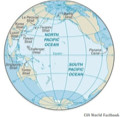
1. Pacific Ocean. 165.2 million km2 and it contains half of the Earthís
ocean water.
© CIA World Factbook

2. June 21, 2022 Photo is Summer Solstice at Stonehenge.
© Readerís Digest, Jessica photo/ Getty Images

3. There are five national parks in NWT: Nahanni, NŠŠts'ihch'oh,
Aulavik, Tuktut Nogait, and Wood Buffalo.
British Columbia has the most, with seven parks. Mount Revelstoke,
Kootenay, Glacier, Yoho, Gwaii Haanas, Pacific Rim, and Gulf
Islands.
© Parks Canada, NŠŠts'ihch'oh National Park Reserve

4. The Ginkgo tree or Ginkgo Biloba is 270 million years old.
© Igor Sheremetyev, Green Ginkgo

Ginkgo Biloba MacAbee BC fossil leaf.
© Wikipedia

5. At Mackenzie Bison Sanctuary near Fort Providence, Northwest
Territories. There are 2000.
© Tessa MacIntosh Spectacular North West Territories, Bison on
Great Slave Lake.

